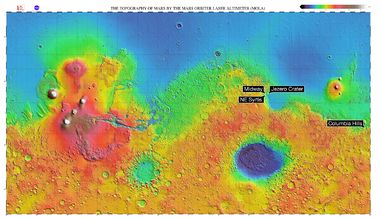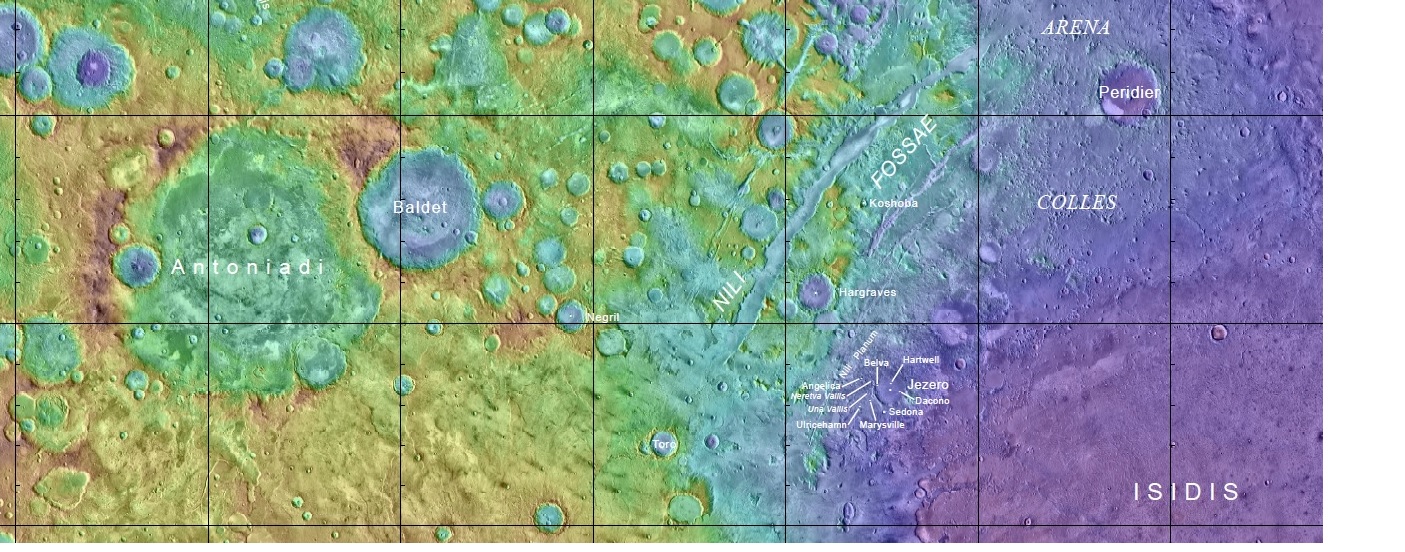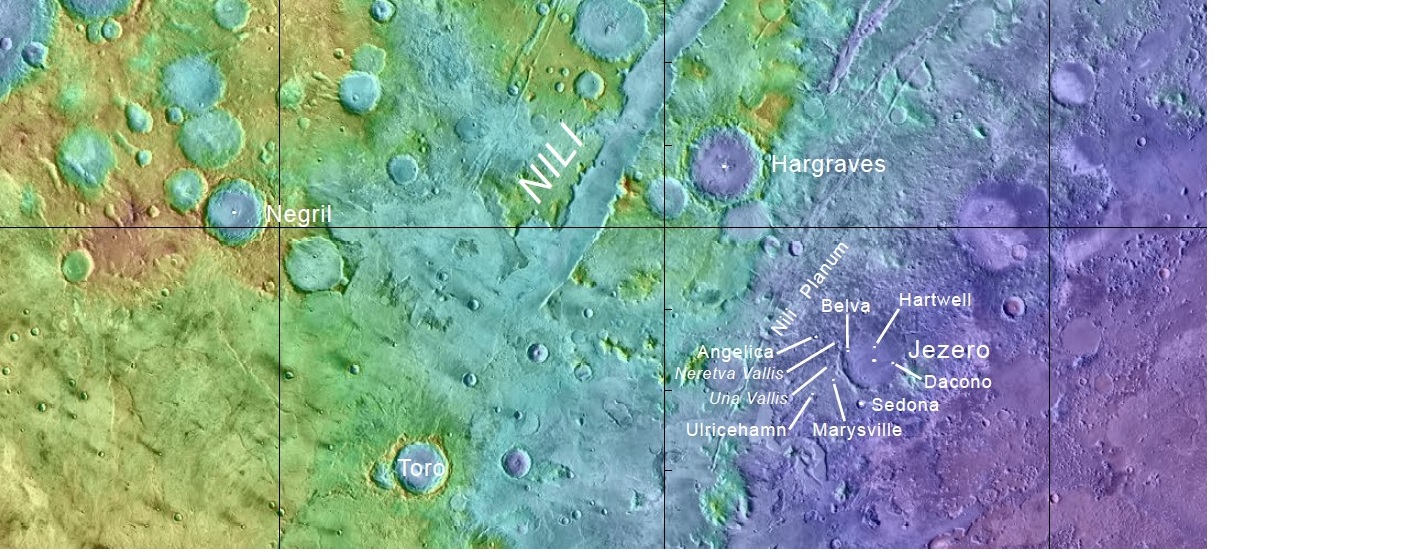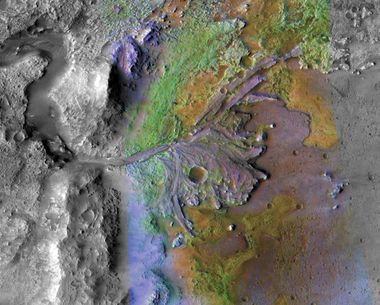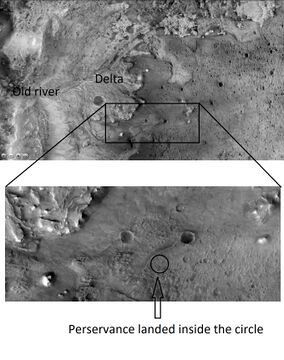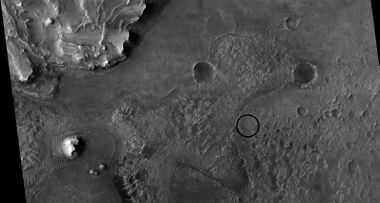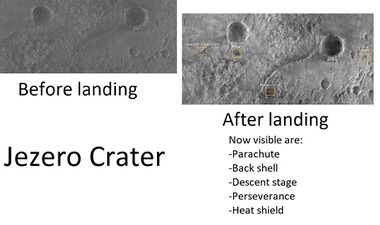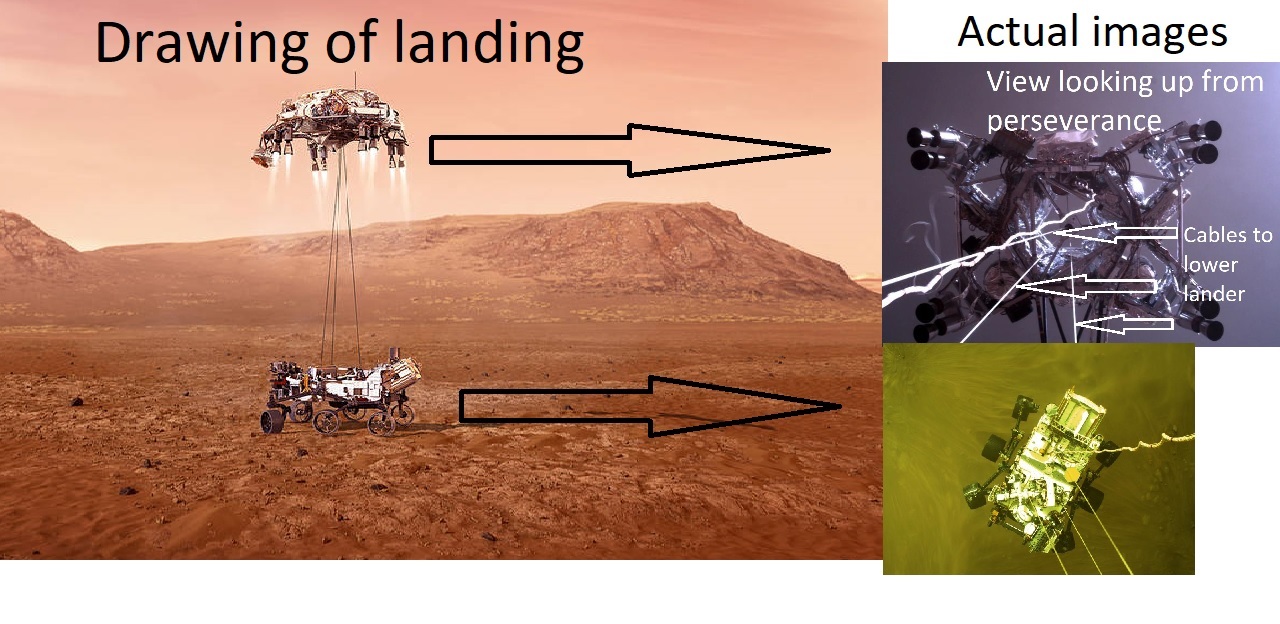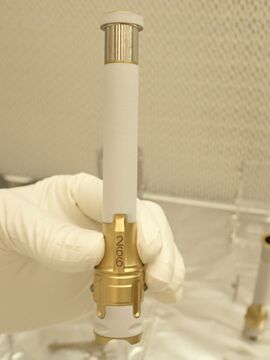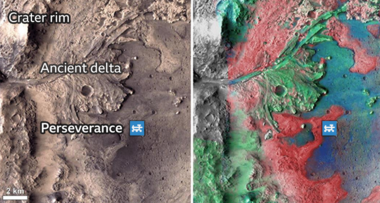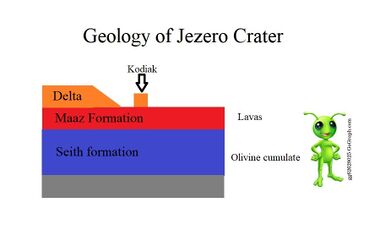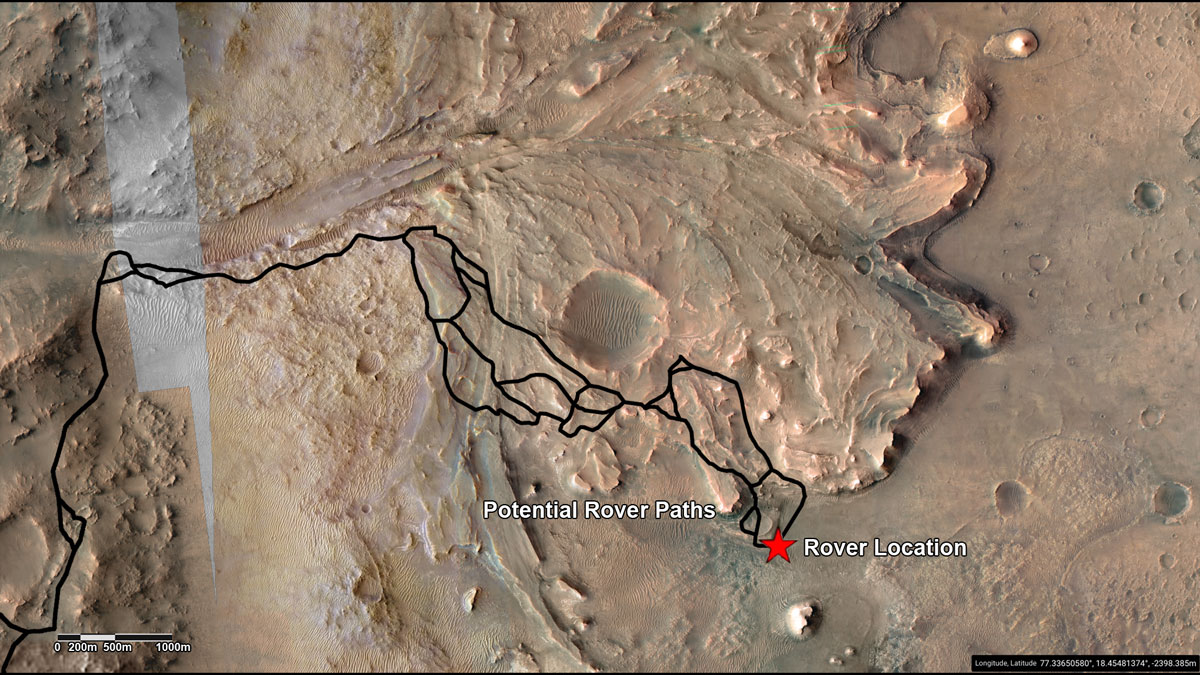Difference between revisions of "Jezero Crater"
Suitupshowup (talk | contribs) m |
|||
| (20 intermediate revisions by 2 users not shown) | |||
| Line 108: | Line 108: | ||
<ref>https://www.science.org/doi/10.1126/sciadv.abn3783</ref> | <ref>https://www.science.org/doi/10.1126/sciadv.abn3783</ref> | ||
| − | In August 2022, four papers were published describing the kinds of rocks found in Jezero Crater so far.<ref>Ground penetrating radar observations of subsurface structures in the floor of Jezero Crater, Mars, Science Advances | + | Perseverance Rover recorded a tall dust devil in the distance on Aug. 30, 2023. |
| + | Scientists calculated that the dust devil was about 2.5 miles (4 kilometers) away and was moving east to west at about 12 mph (19 kph). Its width was about 200 feet (60 meters). Even though only the bottom 387 feet (118 meters) of the devil was visible in the camera frame, scientists estimated its total height at about 1.2 miles (2 kilometers) using the dust devil's shadow.<ref>https://www.jpl.nasa.gov/images/pia26074-martian-whirlwind-takes-the-thorofare</ref> | ||
| + | |||
| + | In August 2022, four papers were published describing the kinds of rocks found in Jezero Crater so far.<ref>Ground penetrating radar observations of subsurface structures in the floor of Jezero Crater, Mars, Science Advances 2022.</ref> <ref> Ground penetrating radar observations of subsurface structures in the floor of Jezero Crater, Mars, Science Advances 2022.</ref> <ref>Y. Liu, An olivine cumulate outcrop on the floor of Jezero crater, Mars, Science (2022)</ref> <ref> K.A. Farley, Aqueously altered igneous rocks sampled on the floor of Jezero crater, Mars, Science (2022). Compositionally and Density Stratified Igneous Terrain in Jezero Crater, Mars, Science Advances (2022). www.science.org/doi/10.1126/sciadv.abo3399</ref> Rather than finding sedimentary rocks as expected for a lakebed, scientists discovered the floor of Jezero contained two types of igneous rock. One formed from volcanic activity at the surface and the other deep underground from magma. Previous to this study, researchers had found a large formation that contained the mineral olivine.<ref>Liu, Y., et al. 2022. An olivine cumulate outcrop on the floor of Jezero crater, Mars. Science. DOI: 10.1126/science.abo2756</ref> This formation of olivine-rich rocks went from the inside edge of Jezero Crater (called the Séítah formation) into the surroundings. It was almost the size of South Carolina. By grinding into rocks, Perseverance found that olivine crystals were large which means that they formed underground in slowly cooling masses of magma (hot, liquid rock).<ref> Liu, Y., et al. 2022. An olivine cumulate outcrop on the floor of Jezero crater, Mars. Science. DOI: 10.1126/science.abo2756</ref> When samples are returned to Earth, scientists will be able to date the rocks and find out when lava last covered the floor. Lakes, with possible life, would have occurred before that time. Thus, we would know when life may have been in the lake.<ref>https://www.space.com/perseverance-mars-rover-suprising-volcanic-rocks</ref> <ref>Farley, K., et al. 2022. Aqueously altered igneous rocks sampled on the floor of Jezero crater. Mars. Science.</ref> <ref> Newman, C., et al. 2022. The dynamic atmospheric and aeolian environment of Jezero crater, Mars. Science Advances. Vol. 8. Number 21</ref> | ||
Researchers recognize a low unit that is a coarsely crystalline olivine-rich rock. Such rocks are known to be formed slowly at the base of large magma bodies. This unit has been named Séítah. Séítah is the lowest exposed stratigraphic unit on Jezero's floor. Carbonates are found in these rocks from reactions with carbon dioxide-rich water. On top of Seitah lies a rock unit called Máaz. It is a lava flow. Voids in these rocks hold perchlorates and sulfates. Those minerals probably resulted from the evaporation of mineral-rich groundwater.<ref> https://www.science.org/doi/10.1126/science.abo2196</ref> <ref>Farley, K., et al. 2022. Aqueously altered igneous rocks sampled on the floor of Jezero crater, Mars. Science. DOI: 10.1126/science.abo2196</ref> | Researchers recognize a low unit that is a coarsely crystalline olivine-rich rock. Such rocks are known to be formed slowly at the base of large magma bodies. This unit has been named Séítah. Séítah is the lowest exposed stratigraphic unit on Jezero's floor. Carbonates are found in these rocks from reactions with carbon dioxide-rich water. On top of Seitah lies a rock unit called Máaz. It is a lava flow. Voids in these rocks hold perchlorates and sulfates. Those minerals probably resulted from the evaporation of mineral-rich groundwater.<ref> https://www.science.org/doi/10.1126/science.abo2196</ref> <ref>Farley, K., et al. 2022. Aqueously altered igneous rocks sampled on the floor of Jezero crater, Mars. Science. DOI: 10.1126/science.abo2196</ref> | ||
| Line 117: | Line 120: | ||
</gallery> | </gallery> | ||
| + | |||
| + | In a press conference on September 15, 2022, scientists described findings from the first 18 months of exploration with the Perseverance Rover. They were excited about finding organic minerals that are probably aromatics or stable molecules of carbon and hydrogen connected to sulfates. Sulfate minerals can preserve information about the watery environments in which they formed. These molecules were found in a place called "Wildcat Ridge." It is believed to have formed as mud and sand settled in a saltwater lake that was evaporating. The Scanning Habitable Environments with Raman & Luminescence for Organics & Chemicals, or SHERLOC was used for the analysis. The rock was scraped ahead of time. Four samples from an Jezero's ancient river delta were collected since July 7. This makes the total collected to 12. | ||
| + | <ref>https://www.cnn.com/2022/09/15/world/perseverance-rover-mars-images-scn/index.html</ref> <ref>https://www.jpl.nasa.gov/news/nasas-perseverance-rover-investigates-geologically-rich-mars-terrain?utm_source=iContact&utm_medium=email&utm_campaign=nasajpl&utm_content=Daily-09152022</ref> Some rock and mineral fragments that are present in the Skinner Ridge sample hint at originating hundreds of miles outside Jezero Crater. This is from a distance that the rover will not be able to travel, but scientists will still get to examine them when the samples are returned to Earth.<ref>https://www.msn.com/en-us/news/technology/perseverance-rover-finds-organic-matter-treasure-on-mars/ar-AA11SJvX?ocid=mailsignout&cvid=d57c0d217b88485f8e8e25525f1a15ef</ref> | ||
| + | |||
| + | |||
| + | Scientists were excited in September 2025 about the possible discovery of remains of life. Perseverance, our rover in Jezero crater, found chemicals that may have been created by anaerobic organisms in the past. Speckles in rocks contained the minerals vivianite, an iron phosphate, and greigite, an iron sulfide. What’s more both formed in close association with organic carbon. On Earth, vivianite frequently forms in lakes and coastal sediments where microbes use iron in their metabolism. They take iron (III) oxide use it, and then give off Ferrous iron (II) as a waste. That ferrous iron reacts with phosphate to form vivianite.<ref> https://www.sciencedirect.com/science/article/abs/pii/S0048969720366067#:~:text=Vivianite%20is%20an%20important%20product,of%20vivianite%20in%20environmental%20field.</ref> <ref>Yuan, Q., et al. 2021. Biosynthesis of vivianite from microbial extracellular electron transfer and environmental application. Science of the total environment. Volume 762, 143076 </ref> | ||
| + | Greigite tends to form when microbes break down sulfate. They change sulfate to sulfide which unites with iron to produce greigite. <ref>Igarashi, K., et al. 2016. Natural synthesis of bioactive greigite by solid–gas reactions. journal/geochimica-et-cosmochimica-acta . Volume 191, 15 October 2016, Pages 47-57. </ref> When found together on Earth, these minerals and organic molecules are usually considered a sort of biosignature.<ref>https://www.scientificamerican.com/article/is-there-life-on-mars-this-rock-may-hold-the-answer/#:~:text=In%20their%20Nature%20study%2C%20Hurowitz,also%20shows%20an%20abrasion%20patch.</ref> <ref>https://www.scientificamerican.com/article/is-there-life-on-mars-this-rock-may-hold-the-answer/#:~:text=In%20their%20Nature%20study%2C%20Hurowitz,also%20shows%20an%20abrasion%20patch.</ref> There are possible, but not probable ways, that these minerals may have been formed without microbes.<ref> Hurowitz, J.A., Tice, M.M., Allwood, A.C. et al. Redox-driven mineral and organic associations in Jezero Crater, Mars. Nature 645, 332–340 (2025). https://doi.org/10.1038/s41586-025-09413-0</ref> They could have been made without biological reactions, including constant high temperatures, acidic conditions, and binding by organic compounds. But, the rocks in this place, called Bright Angel, do not show evidence that they experienced high temperatures or acidic conditions, and it is unknown whether the organic compounds present would’ve been capable of catalyzing the reaction at the expected low temperatures. This chemical evidence of past life appeared in some of the youngest sedimentary rocks the mission has examined. For a long time, we assumed signs of ancient life would be only found in older rock formations. This discovery may mean that Mars could have been habitable for a longer period or later in the planet’s history than previously thought. Older rocks also might hold signs of life that are simply harder to detect.<ref> https://www.nasa.gov/news-release/nasa-says-mars-rover-discovered-potential-biosignature-last-year/#:~:text=In%20higher%2Dresolution%20images%2C%20the,the%20reaction%20at%20low%20temperatures.</ref> The truth about these rocks may not be really known until the samples that were gathered are brought to the Earth. | ||
| + | |||
| + | |||
| + | |||
| + | [[File:Perseverancefuturepath26993 PIA25244-web.jpg| Possible future paths of Perseverance Rover, as revealed in news conference on September 15, 2022.]] | ||
| + | |||
| + | Possible future paths of Perseverance Rover, as revealed in news conference on September 15, 2022. | ||
==References== | ==References== | ||
| Line 134: | Line 150: | ||
==External links== | ==External links== | ||
| + | |||
| + | * https://www.youtube.com/watch? | ||
| + | v=sCgwxizcpo0&list=PLTiv_XWHnOZqCrMU2ppcLjRn1zlDkNx3q Perseverance explores the Jezero Crater Delta | ||
* [https://www.youtube.com/watch?v=D-SCOHj8u-A Water on Mars - James Secosky - 2021 Mars Society Virtual Convention -- Tells where water was and where ice is today on Mars (34 minutes)] | * [https://www.youtube.com/watch?v=D-SCOHj8u-A Water on Mars - James Secosky - 2021 Mars Society Virtual Convention -- Tells where water was and where ice is today on Mars (34 minutes)] | ||
Latest revision as of 10:18, 11 September 2025
Jezero crater was chosen as the landing site for the Mars 2020 rover mission.[1] [2] [3] Perseverance was the name picked for the rover; it landed right on target near the delta on February 18, 2021.[4]
Jezero is an impact crater located at 18.855 N and 77.519 E (282.481 W) in the Syrtis Major quadrangle.[5] [6] It is 47.52 Km in diameter.[7] The crater was named after one of the towns with this name in Bosnia and Herzegovina.[8]
Features near Jezero Crater
Close view of features in and around Jezero Crater
Rivers on the left side of Jezero carried water into the crater, while the overflow went out at the upper right.
Drawing and actual pictures of Perseverance actual landing on Mars
This is the first 360-degree panorama taken by Mastcam-Z, a zoomable pair of cameras aboard NASA’s Perseverance Mars rover.
Rocket Scour and Wheel Prints https://photojournal.jpl.nasa.gov/catalog/PIA24488 Taken on March 5, 2021, this color-calibrated image from a Navigation Camera aboard NASA's Mars 2020 Perseverance rover shows tracks from the rover's first drive (darker marks in the foreground) and an area scoured by the Mars 2020 mission's descent stage rockets (lighter-colored area in the middle ground).
Features in Jezero Crater near delta
Distances from landing site to various features in Jezero Crater
 Possible paths for Perseverance in Jezero Crater Mesa is shown from the ground and from orbit.
Possible paths for Perseverance in Jezero Crater Mesa is shown from the ground and from orbit.
Thought to have once been flooded with water, the crater contains a fan-delta deposit rich in clays.[9] The lake in the crater was present when valley networks were forming on Mars.[10] [11] Besides having a delta, the crater shows point bars and inverted channels. From a study of the delta and channels, it was concluded that water stayed in the lake for a time; it did not experience times when the water went down. It probably formed when there was continual surface runoff.[12] Jezero Crater is found on the western edge of Isidis Planitia, which is a giant impact basin just north of the Martian equator. This location contains some of the oldest and most scientifically interesting landscapes of Mars. It is thought that Jezero may hold ancient organic molecules and other signs of microbial life because water and sediments collected in the crater billions of years ago when conditions were much more favorable for life.
A team, lead by Briony Horgan used the Compact Reconnaissance Imaging Spectrometer for Mars (CRISM), high resolution imagery, and digital elevation models, to discover places in Jezero Crater that contain carbonates. These minerals they named “Marginal Carbonates” are found along the inside margin of the crater, near the largest valley and in a delta in the west. The authors of the paper believe they were formed in an old lake in Jezero. Evidence of life could be found in these deposits by the 2020 Rover. Even large fossils of strmatolites could be present.[13] [14]
The Mars 2020 rover mission will be able to examine at least 5 types of rock, including clays and carbonates.[15] These can preserve signs of ancient life. Additional materials probably washed in from the surroundings; therefore, we will be able to determine mineral information about the area around the crater.
Activities and discoveries by Perseverance
On September 6, 2021 NASA announced that Perseverance rover collected its first sample of a Martian rock. Perseverance’s rotary-percussive drill on its robotic arm cored into a flat, briefcase-size rock. It has been called “Rochette.” The sample was slightly thicker than a pencil. It is now enclosed in an airtight titanium sample tube, making it available for retrieval in the future. NASA and ESA (European Space Agency) are planning future missions to return the rover’s sample tubes to Earth. This first sample was placed in sample tube serial number 266.[16]
The collection from Rochette came a month after the rover tried and failed to collect a sample from another rock, called “Roubion.” The first sample attempt failed because the rock was softer; hence it crumbled.[17]
Before drilling to get the core sample from the rock, scientists used instruments on the rover to learn more about its composition. They determined that the rock was basaltic and contained salt crystals. The salts may have formed from groundwater or more likely from liquid water that had evaporated into the thin Martian atmosphere. It is hoped that the crystals may also have trapped tiny bubbles of water.[18]
In October 2021, an article was published online by the journal Science about some initial results from photos from Perseverance. It was confirmed that there is an actual delta in Jezero Crater because the typical layers in a delta were seen. Scientists called them bottomsets, foresets and topsets. They were found in a steeply fronted Gilbert-type delta. Since meter-scale boulders were found that may have traveled tens of km, the researchers believe that much rapidly moving water was present at times.[19] [20]
In December 2021, it was announced that some of the rocks in Jezero were igneous.[21] [22] They had once been molten and then slowly cooled. At first ,it looked like many of the rocks photographed by Jezero's camera were sedimentary due to the presence of layering. But, when examined closely, the rocks revealed the mineral olivine surrounded by the mineral pyroxene. That arrangement happens in thick magma bodies and geologists call this type of texture "Cumulate."[23] Carbonate and sulfate minerals were also detected which means that the rocks had been altered by water. The rocks studied were in location nicknamed "South Séítah." "Séítah" (means "amidst the sand" in the Navajo language.[24] The instrument used for this analysis was the Planetary Instrument for X-ray Lithochemistry (PIXL). It uses X-ray fluorescence to determine the elemental composition of rocks.[25]
Two formations, called Maaz and Seitah, are both igneous. Seitah is classified as an olivine-rich cumulate which means it cooled slowly in a thick mass. Maaz is rich in the minerals pyroxene and plagioclase. It cooled quicker on the top of a mass of magma or lava. Water has altered the chemistry of the rock because carbonate, iron oxides, amorphous silicates, sulfates, halite, perchlorates, phosphates, and possible phyllosilicates were found[26] [27]
At the same time, NASA said that organic compounds were found by the SHERLOC (Scanning Habitable Environments with Raman & Luminescence for Organics & Chemicals) instrument. These organics are not only inside of abraded rocks SHERLOC analyzed, but in the dust on non-abraded rock.
Perseverance uses ground-penetrating radar to look under the surface of Mars. RIMFAX (Radar Imager for Mars' Subsurface Experiment) produces a “radargram” of subsurface features up to about 33 feet (10 meters) deep. Scientists found that rock formations with a downward tilt continue into the subsurface.[28]
Many dust devils were detected by Perseverance. In the first 216 Martian days (Sols), the Perseverance Rover in Jezero Crater found that at least four dust devils pass Perseverance on a typical Martian day and that more than one per hour passes by during a peak hourlong period just after noon. Perseverance made these observations mostly with the its cameras and a group of sensors in the Mars Environmental Dynamics Analyzer (MEDA). MEDA includes wind sensors and light sensors.[29] [30]
Perseverance Rover recorded a tall dust devil in the distance on Aug. 30, 2023. Scientists calculated that the dust devil was about 2.5 miles (4 kilometers) away and was moving east to west at about 12 mph (19 kph). Its width was about 200 feet (60 meters). Even though only the bottom 387 feet (118 meters) of the devil was visible in the camera frame, scientists estimated its total height at about 1.2 miles (2 kilometers) using the dust devil's shadow.[31]
In August 2022, four papers were published describing the kinds of rocks found in Jezero Crater so far.[32] [33] [34] [35] Rather than finding sedimentary rocks as expected for a lakebed, scientists discovered the floor of Jezero contained two types of igneous rock. One formed from volcanic activity at the surface and the other deep underground from magma. Previous to this study, researchers had found a large formation that contained the mineral olivine.[36] This formation of olivine-rich rocks went from the inside edge of Jezero Crater (called the Séítah formation) into the surroundings. It was almost the size of South Carolina. By grinding into rocks, Perseverance found that olivine crystals were large which means that they formed underground in slowly cooling masses of magma (hot, liquid rock).[37] When samples are returned to Earth, scientists will be able to date the rocks and find out when lava last covered the floor. Lakes, with possible life, would have occurred before that time. Thus, we would know when life may have been in the lake.[38] [39] [40]
Researchers recognize a low unit that is a coarsely crystalline olivine-rich rock. Such rocks are known to be formed slowly at the base of large magma bodies. This unit has been named Séítah. Séítah is the lowest exposed stratigraphic unit on Jezero's floor. Carbonates are found in these rocks from reactions with carbon dioxide-rich water. On top of Seitah lies a rock unit called Máaz. It is a lava flow. Voids in these rocks hold perchlorates and sulfates. Those minerals probably resulted from the evaporation of mineral-rich groundwater.[41] [42]
In a press conference on September 15, 2022, scientists described findings from the first 18 months of exploration with the Perseverance Rover. They were excited about finding organic minerals that are probably aromatics or stable molecules of carbon and hydrogen connected to sulfates. Sulfate minerals can preserve information about the watery environments in which they formed. These molecules were found in a place called "Wildcat Ridge." It is believed to have formed as mud and sand settled in a saltwater lake that was evaporating. The Scanning Habitable Environments with Raman & Luminescence for Organics & Chemicals, or SHERLOC was used for the analysis. The rock was scraped ahead of time. Four samples from an Jezero's ancient river delta were collected since July 7. This makes the total collected to 12. [43] [44] Some rock and mineral fragments that are present in the Skinner Ridge sample hint at originating hundreds of miles outside Jezero Crater. This is from a distance that the rover will not be able to travel, but scientists will still get to examine them when the samples are returned to Earth.[45]
Scientists were excited in September 2025 about the possible discovery of remains of life. Perseverance, our rover in Jezero crater, found chemicals that may have been created by anaerobic organisms in the past. Speckles in rocks contained the minerals vivianite, an iron phosphate, and greigite, an iron sulfide. What’s more both formed in close association with organic carbon. On Earth, vivianite frequently forms in lakes and coastal sediments where microbes use iron in their metabolism. They take iron (III) oxide use it, and then give off Ferrous iron (II) as a waste. That ferrous iron reacts with phosphate to form vivianite.[46] [47]
Greigite tends to form when microbes break down sulfate. They change sulfate to sulfide which unites with iron to produce greigite. [48] When found together on Earth, these minerals and organic molecules are usually considered a sort of biosignature.[49] [50] There are possible, but not probable ways, that these minerals may have been formed without microbes.[51] They could have been made without biological reactions, including constant high temperatures, acidic conditions, and binding by organic compounds. But, the rocks in this place, called Bright Angel, do not show evidence that they experienced high temperatures or acidic conditions, and it is unknown whether the organic compounds present would’ve been capable of catalyzing the reaction at the expected low temperatures. This chemical evidence of past life appeared in some of the youngest sedimentary rocks the mission has examined. For a long time, we assumed signs of ancient life would be only found in older rock formations. This discovery may mean that Mars could have been habitable for a longer period or later in the planet’s history than previously thought. Older rocks also might hold signs of life that are simply harder to detect.[52] The truth about these rocks may not be really known until the samples that were gathered are brought to the Earth.
Possible future paths of Perseverance Rover, as revealed in news conference on September 15, 2022.
References
- ↑ https://www.space.com/42486-mars-2020-rover-jezero-crater-landing-site.html
- ↑ https://www.jpl.nasa.gov/news/news.php?feature=7286&utm_source=iContact&utm_medium=email&utm_campaign=nasajpl&utm_content=daily20181119-2
- ↑ https://www.sciencenews.org/article/nasa-mars-2020-rover-landing-site-ancient-alien-life-river-delta?utm_source=email&utm_medium=email&utm_campaign=latest-newsletter-v2
- ↑ https://mars.nasa.gov/news/8865/touchdown-nasas-mars-perseverance-rover-safely-lands-on-red-planet/
- ↑ https://hirise.lpl.arizona.edu/PSP_007925_1990
- ↑ https://www.space.com/mars-2020-alien-life-hunt-microfossils.html?utm_source=Selligent&utm_medium=email&utm_campaign=10118&utm_content=20191116_SDC_Newsletter+-+adhoc+&utm_term=2946561&m_i=LKHS2VBMPdPBKbRsJssJ6HqkTujMa1rGRCQddp5zz8Ss3OSL%2Bdjwc5LY%2BNjlmSR30MzcdNIUCuC1q%2Bfn0ySWT1TcOiknL7DjLx
- ↑ https://planetarynames.wr.usgs.gov/Feature/14300
- ↑ https://planetarynames.wr.usgs.gov/Feature/14300
- ↑ https://hirise.lpl.arizona.edu/PSP_007925_1990
- ↑ Fassett and Head Iii, 2005 C.I. Fassett, J.W. Head Iii Fluvial sedimentary deposits on Mars: ancient deltas in a crater lake in the Nili Fossae region Geophys. Res. Lett., 32 (14) (2005), 10.1029/2005GL023456 n/a–n/a
- ↑ Fassett and Head Iii, 2008 C.I. Fassett, J.W. Head Iii. Valley network-fed, open-basin lakes on Mars: distribution and implications for Noachian surface and subsurface hydrology Icarus, 198 (1) (2008), pp. 37-56, 10.1016/j.icarus.2008.06.016
- ↑ Goudge, T., et al. 2017. STRATIGRAPHY AND EVOLUTION OF DELTA CHANNEL DEPOSITS, JEZERO CRATER, MARS. Lunar and Planetary Science XLVIII (2017). 1195.pdf.
- ↑ https://www.sciencedirect.com/science/article/pii/S0019103518306067
- ↑ Horgan, B., et al. 2019. The mineral diversity of Jezero crater: Evidence for possible lacustrine carbonates on Mars. Icarus. In press. https://doi.org/10.1016/j.icarus.2019.113526
- ↑ https://www.jpl.nasa.gov/news/news.php?feature=7539&utm_source=iContact&utm_medium=email&utm_campaign=nasajpl&utm_content=daily-20191112-1
- ↑ https://mars.nasa.gov/news/9029/nasas-perseverance-rover-collects-first-mars-rock-sample/
- ↑ https://spacenews.com/perseverance-collects-first-mars-samples/
- ↑ https://mars.nasa.gov/news/9036/nasas-perseverance-rover-collects-puzzle-pieces-of-mars-history/
- ↑ https://www.science.org/doi/10.1126/science.abl4051
- ↑ Mangold, N., al al. 2021. Perseverance rover reveals an ancient delta-lake system and flood deposits at Jezero crater, Mars. Science. DOI: 10.1126/science.abl4051
- ↑ https://www.hou.usra.edu/meetings/lpsc2022/pdf/1530.pdf
- ↑ Schmidt, M., et al. 2022. HIGHLY DIFFERENTIATED BASALTIC LAVAS EXAMINED BY PIXL IN JEZERO CRATER. 53rd Lunar and Planetary Science Conference. 1530.pdf
- ↑ https://www.bbc.com/news/science-environment-59677383
- ↑ https://www.bbc.com/news/science-environment-59677383
- ↑ https://www.jpl.nasa.gov/news/nasas-perseverance-mars-rover-makes-surprising-discoveries
- ↑ https://www.hou.usra.edu/meetings/lpsc2022/pdf/1798.pdf
- ↑ Sun, V., et al. 2022. EXPLORING THE JEZERO CRATER FLOOR: OVERVIEW OF RESULTS FROM THE MARS 2020 PERSEVERANCE ROVER’S FIRST SCIENCE CAMPAIGN. 53rd Lunar and Planetary Science Conference (2022. 1798.pdf
- ↑ https://www.jpl.nasa.gov/news/nasas-perseverance-mars-rover-makes-surprising-discoveries
- ↑ https://www.jpl.nasa.gov/news/nasas-perseverance-studies-the-wild-winds-of-jezero-crater?utm_source=iContact&utm_medium=email&utm_campaign=nasajpl&utm_content=Day%20in%20Review%20-%206-1-22
- ↑ https://www.science.org/doi/10.1126/sciadv.abn3783
- ↑ https://www.jpl.nasa.gov/images/pia26074-martian-whirlwind-takes-the-thorofare
- ↑ Ground penetrating radar observations of subsurface structures in the floor of Jezero Crater, Mars, Science Advances 2022.
- ↑ Ground penetrating radar observations of subsurface structures in the floor of Jezero Crater, Mars, Science Advances 2022.
- ↑ Y. Liu, An olivine cumulate outcrop on the floor of Jezero crater, Mars, Science (2022)
- ↑ K.A. Farley, Aqueously altered igneous rocks sampled on the floor of Jezero crater, Mars, Science (2022). Compositionally and Density Stratified Igneous Terrain in Jezero Crater, Mars, Science Advances (2022). www.science.org/doi/10.1126/sciadv.abo3399
- ↑ Liu, Y., et al. 2022. An olivine cumulate outcrop on the floor of Jezero crater, Mars. Science. DOI: 10.1126/science.abo2756
- ↑ Liu, Y., et al. 2022. An olivine cumulate outcrop on the floor of Jezero crater, Mars. Science. DOI: 10.1126/science.abo2756
- ↑ https://www.space.com/perseverance-mars-rover-suprising-volcanic-rocks
- ↑ Farley, K., et al. 2022. Aqueously altered igneous rocks sampled on the floor of Jezero crater. Mars. Science.
- ↑ Newman, C., et al. 2022. The dynamic atmospheric and aeolian environment of Jezero crater, Mars. Science Advances. Vol. 8. Number 21
- ↑ https://www.science.org/doi/10.1126/science.abo2196
- ↑ Farley, K., et al. 2022. Aqueously altered igneous rocks sampled on the floor of Jezero crater, Mars. Science. DOI: 10.1126/science.abo2196
- ↑ https://www.cnn.com/2022/09/15/world/perseverance-rover-mars-images-scn/index.html
- ↑ https://www.jpl.nasa.gov/news/nasas-perseverance-rover-investigates-geologically-rich-mars-terrain?utm_source=iContact&utm_medium=email&utm_campaign=nasajpl&utm_content=Daily-09152022
- ↑ https://www.msn.com/en-us/news/technology/perseverance-rover-finds-organic-matter-treasure-on-mars/ar-AA11SJvX?ocid=mailsignout&cvid=d57c0d217b88485f8e8e25525f1a15ef
- ↑ https://www.sciencedirect.com/science/article/abs/pii/S0048969720366067#:~:text=Vivianite%20is%20an%20important%20product,of%20vivianite%20in%20environmental%20field.
- ↑ Yuan, Q., et al. 2021. Biosynthesis of vivianite from microbial extracellular electron transfer and environmental application. Science of the total environment. Volume 762, 143076
- ↑ Igarashi, K., et al. 2016. Natural synthesis of bioactive greigite by solid–gas reactions. journal/geochimica-et-cosmochimica-acta . Volume 191, 15 October 2016, Pages 47-57.
- ↑ https://www.scientificamerican.com/article/is-there-life-on-mars-this-rock-may-hold-the-answer/#:~:text=In%20their%20Nature%20study%2C%20Hurowitz,also%20shows%20an%20abrasion%20patch.
- ↑ https://www.scientificamerican.com/article/is-there-life-on-mars-this-rock-may-hold-the-answer/#:~:text=In%20their%20Nature%20study%2C%20Hurowitz,also%20shows%20an%20abrasion%20patch.
- ↑ Hurowitz, J.A., Tice, M.M., Allwood, A.C. et al. Redox-driven mineral and organic associations in Jezero Crater, Mars. Nature 645, 332–340 (2025). https://doi.org/10.1038/s41586-025-09413-0
- ↑ https://www.nasa.gov/news-release/nasa-says-mars-rover-discovered-potential-biosignature-last-year/#:~:text=In%20higher%2Dresolution%20images%2C%20the,the%20reaction%20at%20low%20temperatures.
See Also
- Columbus Crater
- Curiosity
- Gale Crater
- Holden Crater
- Mars Perseverance Rover
- Ritchey Crater
- Rivers on Mars
- Syrtis Major quadrangle
- Water
External links
v=sCgwxizcpo0&list=PLTiv_XWHnOZqCrMU2ppcLjRn1zlDkNx3q Perseverance explores the Jezero Crater Delta
- https://www.youtube.com/watch?v=uzeQ1aha5D4 NASA's Mars 2020 Crater Will Land in Jezero Crater https://www.youtube.com/watch?v=uzeQ1aha5D4 NASA's Mars 2020 Crater Will Land in Jezero Crater
- https://www.youtube.com/watch?v=63PWQeQGfhc Layered Material Cut by a Valley Connected to East Jezero Crater https://www.youtube.com/watch?v=63PWQeQGfhc Layered Material Cut by a Valley Connected to East Jezero Crater
- https://www.youtube.com/watch?v=jev51W_j_5w HiClip mini 4K: In Praise of Jezero Crater https://www.youtube.com/watch?v=jev51W_j_5w HiClip mini 4K: In Praise of Jezero Crater
- The Evolution of Water on Mars
- Photogeologic Map of the Perseverance Rover Field Site in Jezero Crater Constructed by the Mars 2020 Science Team
